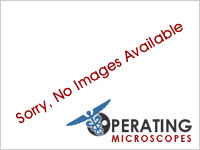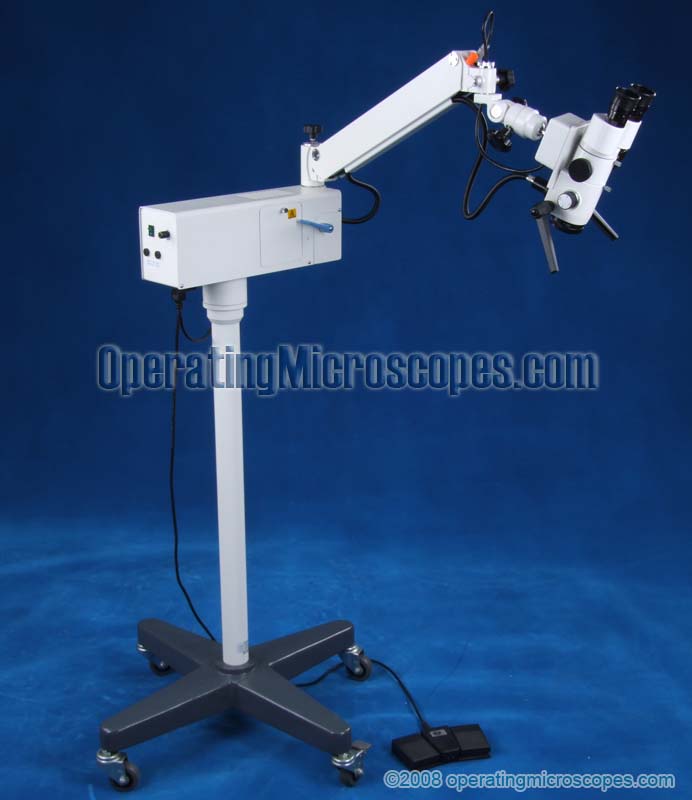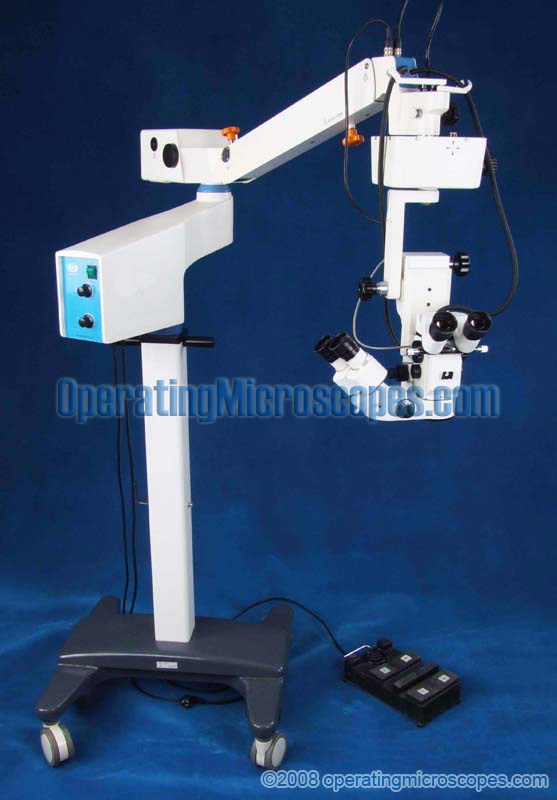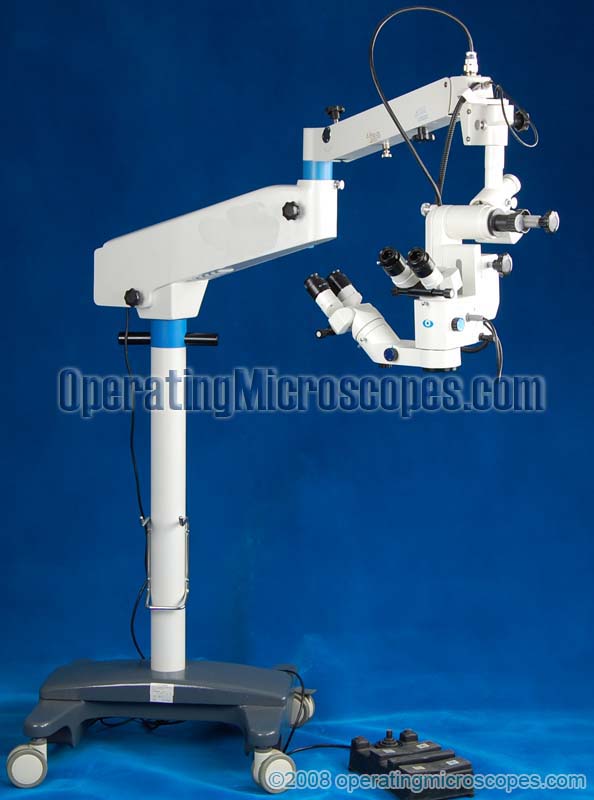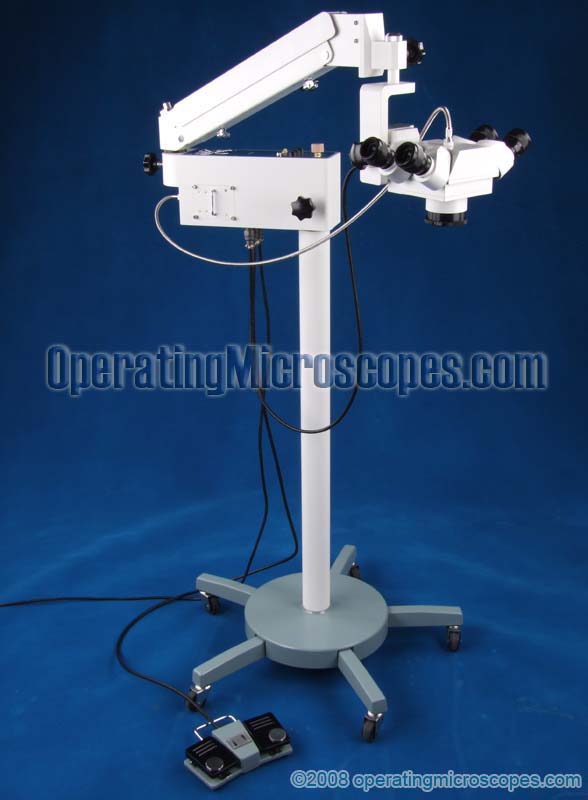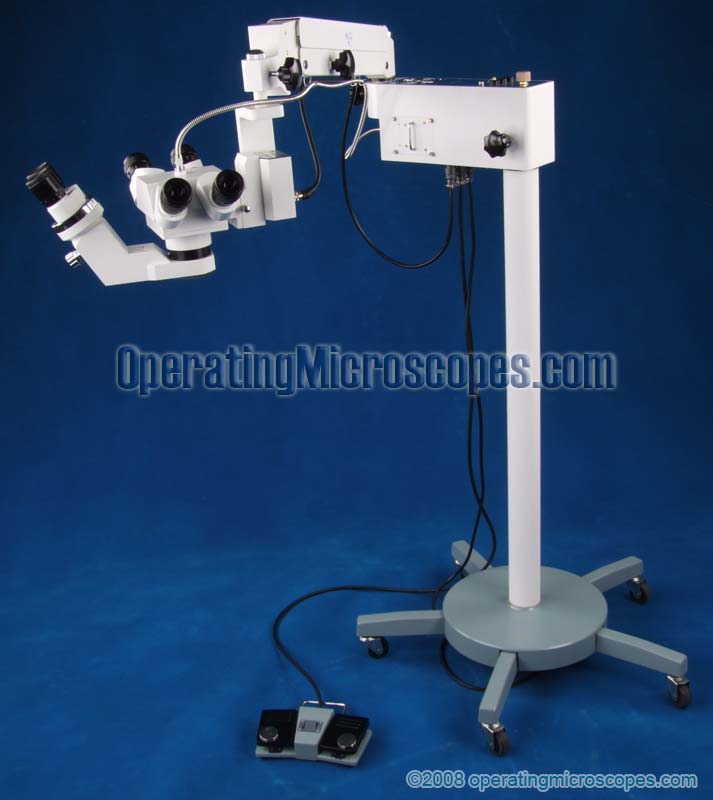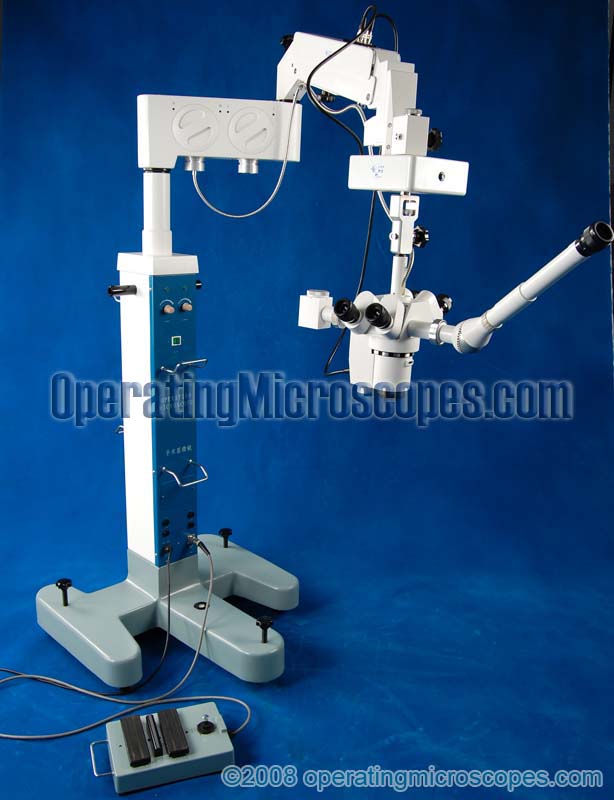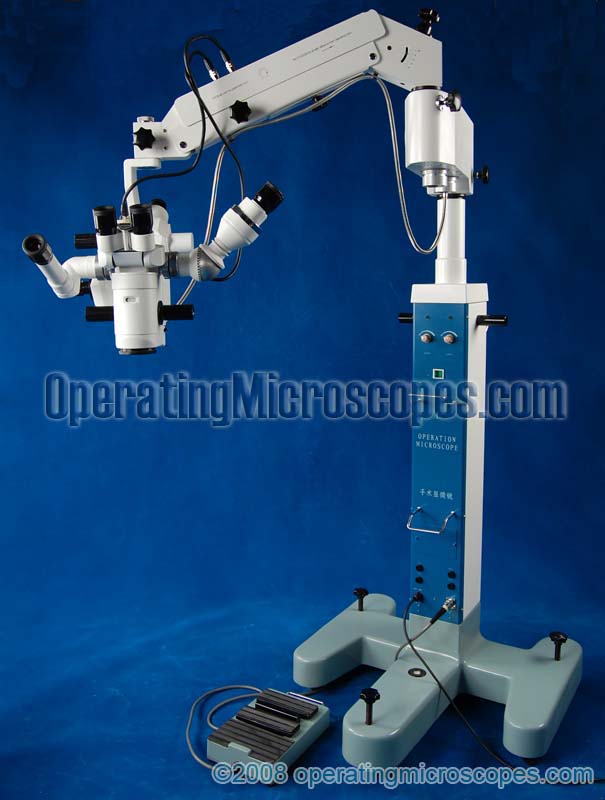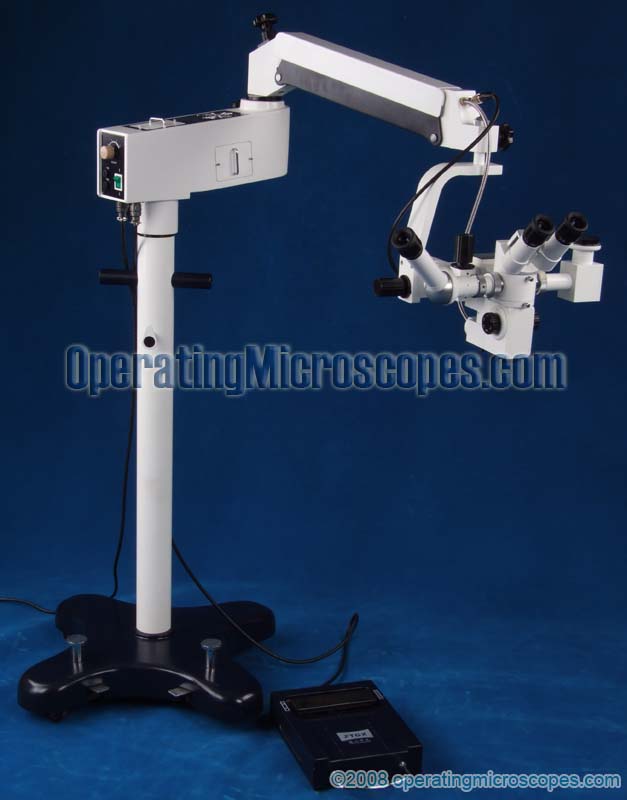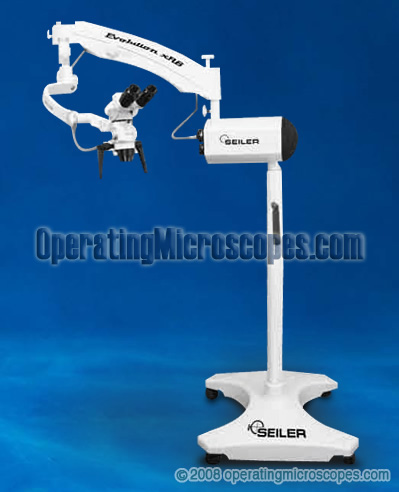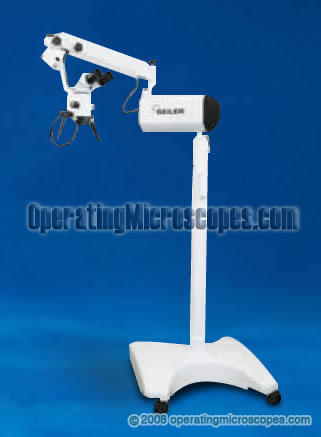This model of surgical microscope has its main use in the fields of dentistry and ENT (ear, nose, throat medical practice) and other general microsurgical procedures in the medical field. The viewing binocular head is a straight angled version as is typically used in these applications. The main feature of this operation microscope is the motorization of the focusing with controls on the foot pad. The equipment is also portable, being mounted on a rolling wheel base. There is no option for an assistant or teaching head. The eyepieces cannot be tilted on a rotating angle as they are on a fixed angle. To tilt the head, the physician tilts the complete head assembly.
The microscope head has a three step magnification allowing different powers to be viewed. There is no zoom optics. The lens is made from high quality imported German glass for reduction in lens aberration. All optics are multi-coated and include mildew proof and anti-reflection coatings. A useful option is a beam splitter, ccd camera adapter, and ccd camera for taking the video image to a cctv monitor for medical personnel in the room to see, or for the operation procedure to be videotaped.
Multifunctional Microscopes

model: MS-111
model: MS-113
This model of ENT / dental surgical operating microscope is identical to model MS-111 with the exception of it having an improved illumination system, longer reach, and a taller column size. The improved lighting gives better and brighter imaging for the ENT surgeon.
model: MS-116
This model of operation microscope is multi-functional and used for a variety of microsurgical applications such as general surgery, ophthalmology, ophthalmic eye surgery, and orthopaedics (orthopedics, surgery related to musculoskeletal injuries). The main features of this surgical microscope are the motorization of the focusing controls and x-y location of field of view. The motors are controlled by the foot.
The main head is binocular. The assistant (also called teaching) head is also a binocular. Neither of the heads are the tiltable versions as they are on a fixed angle. To tilt the heads, the surgeon needs to tilt the complete head assembly. One motorized function locates the area of interest in the viewing optics by moving the whole head assembly on an X - Y grid. This motor centers the specimen in the field of view.
The main head is binocular. The assistant (also called teaching) head is also a binocular. Neither of the heads are the tiltable versions as they are on a fixed angle. To tilt the heads, the surgeon needs to tilt the complete head assembly. One motorized function locates the area of interest in the viewing optics by moving the whole head assembly on an X - Y grid. This motor centers the specimen in the field of view.
model: MS-118
This surgical operating microscope is mainly used for neurosurgery and brain microsurgery but can also be used for orthopedics. The main advantage of this microscope is that both the main surgeon’s head and the assistant’s head are able to pivot their angle of inclination. They both pivot independently. The main head and the assistant’s head are both binocular versions. The main head has magnifications that are selectable, allowing five steps of magnification levels. The assistant head is a three step magnification version. The magnifications are independently set. The assistant’s head has a fine focus that allows it to be in sharp focus when the main head is in focus. This is not a zoom optics microscope. The equipment has hand controls as well as a foot controlled motorized pedal that controls the focusing as well as rotates the complete head assembly.
An optional monocular teaching tube can be installed, allowing viewing of the surgical procedure by a third medical doctor.
An optional monocular teaching tube can be installed, allowing viewing of the surgical procedure by a third medical doctor.
model: MS-134
This model of operating microscope is primarily used for orthopedic and hand microsurgery. The main features of this surgical microscope are the motorization of the focusing. The controls are on the foot pad. It also features two identical binocular heads for two surgeons to simultaneously view the operating procedure. One head would be considered the main surgeon’s head and the other would be the assistant (also called teaching) head.
The dual binocular heads each have a single fixed magnification of 10x using the included f200mm focal length bottom objective lens. If an optional f250mm objective lens is used, the magnification is changed to a fixed 8x. It does not have selectable magnifications and does not have zoom optics.
The dual binocular heads each have a single fixed magnification of 10x using the included f200mm focal length bottom objective lens. If an optional f250mm objective lens is used, the magnification is changed to a fixed 8x. It does not have selectable magnifications and does not have zoom optics.
model: MS-135
This model of operating microscope can be used for both ophthalmic and orthopedic microsurgery.
This model is similar to model MS-134 but instead of having a beam splitter, it has a binocular teaching head assembly, allowing a third observer/assistant to view the microsurgery simultaneously. This model does not have an option for a beam splitter, ccd camera adapter, and ccd camera.
This model is similar to model MS-134 but instead of having a beam splitter, it has a binocular teaching head assembly, allowing a third observer/assistant to view the microsurgery simultaneously. This model does not have an option for a beam splitter, ccd camera adapter, and ccd camera.
model: MS-139
This model of operating microscope is primarily used for plastic surgery and orthopedic surgery, as well as hand surgery. It is the needed optical tool for doing anastomosis of capillary and nerve connections in different kinds of microsurgeries. This process of anastomosis refers to the connection of two different tubular structures in the human body such as blood vessels, intestine, arteries, and veins.
The main features of this surgical microscope are the motorization of the focusing, the zoom magnifications, and the centering of the optics over the working field of view. The motorized centering function locates the specimen in the viewing optics by moving the whole head assembly on an X - Y grid (40mm x 40mm maximum). This motor centers the specimen in the field of view. The controls are on the foot pad. It also features two identical binocular heads for two surgeons to simultaneously view the operating procedure. One head would be considered the main surgeon’s head and the other would be the assistant (also called teaching) head.
The main features of this surgical microscope are the motorization of the focusing, the zoom magnifications, and the centering of the optics over the working field of view. The motorized centering function locates the specimen in the viewing optics by moving the whole head assembly on an X - Y grid (40mm x 40mm maximum). This motor centers the specimen in the field of view. The controls are on the foot pad. It also features two identical binocular heads for two surgeons to simultaneously view the operating procedure. One head would be considered the main surgeon’s head and the other would be the assistant (also called teaching) head.
model: MS-140
This model of operating microscope is used for a variety of microsurgical applications and is considered a multifunctional unit.
The main features of this surgical microscope are the full motorization of the focusing, the zoom magnification, and the movement of the microscope head on the arm. The controls are on the foot pad as well as mounted by the microscope head for easy utilization.
It features a single binocular master surgeon’s head as well as a binocular head for an assistant surgeon. This allows for two surgeons to simultaneously view the operating procedure. In addition, a monocular teaching/assistant head is also included. All heads see the same optics and zoom magnification.
The main features of this surgical microscope are the full motorization of the focusing, the zoom magnification, and the movement of the microscope head on the arm. The controls are on the foot pad as well as mounted by the microscope head for easy utilization.
It features a single binocular master surgeon’s head as well as a binocular head for an assistant surgeon. This allows for two surgeons to simultaneously view the operating procedure. In addition, a monocular teaching/assistant head is also included. All heads see the same optics and zoom magnification.
model: MS-142
This model of operating microscope is used for a variety of microsurgical applications and is considered a multifunctional unit.
One nice feature of this surgical microscope is the motorization of the focusing with the controls on the foot pad.
It features a single binocular master surgeon’s head as well as a monocular head for an assistant surgeon. This allows for two surgeons to simultaneously view the operating procedure.
One nice feature of this surgical microscope is the motorization of the focusing with the controls on the foot pad.
It features a single binocular master surgeon’s head as well as a monocular head for an assistant surgeon. This allows for two surgeons to simultaneously view the operating procedure.
model: MS-EVO-ENT
Multifunction operating microscope with 6 magnifications. Binocular head is a fixed incline of 45 degrees. Mounting options include wall, ceiling, high wall, floor, and table mount. Microscope proudly made in USA.
model: MS-IQ-ENT-180
Multifunction operating microscope with 3 magnifications. Binocular head is inclinable from 0 to 180 degrees. Mounting options include wall, ceiling, high wall, floor, and table mount. Microscope proudly made in USA.
model: MS-IQ-ENT
This operating microscope has 3 magnifications. Binocular head is a fixed incline of 45 degrees. Mounting options include wall, ceiling, high wall, floor, and table mount. Microscope proudly made in USA.
call us:  or email
or email

 or email
or email
Categories
Dental
Dental Microscopes
Dental Microscopes
Ophthalmic
Ophthalmic Microscopes
Ophthalmic Microscopes
Gynecology
Gynecology Colposcopes
Gynecology Colposcopes

